Articles: Adoranten 2019
Bronze Age Glass and Amber. Evidence of Bronze Age long distance exchange by Jeanette Varberg, Flemming Kaul & Bernard Gratuze
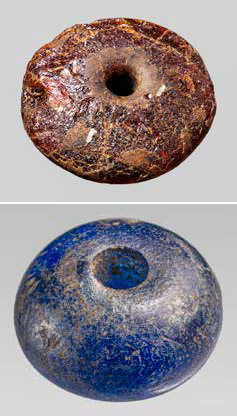 Small beads of glass and amber tell a fascinating story of long distance exchange during the Bronze Age, connecting Egypt and Mesopotamia with South Scandinavia. The beads themselves do not carry any iconography in a narrow sense. However, the material and the colour of the glass beads and of the amber beads may entail a deeper meaning related to Bronze Age religion and cosmology.
During the last decades, the methods related to chemical analyses of ancient glass have improved dramatically, complemented by the increasing amount of material available for comparative studies. By recognizing different chemical trace elements related to the vitreous material itself as well as the colorant, it is now possible to identify glass from Egypt and Mesopotamia, and to distinguish glass from these two principal production areas of the Middle Bronze Age. It is also possible identify glass from the later glass production workshops in Northern Italy, in the Po Plain, such as Frattesina (after c. 1200 BC) (Walton et al. 2009; Shortland 2012; Walton et al. 2012; Gratuze 2013; Rehren & Freestone 2015). Thus, every glass bead, from well dated Danish burial contexts, can reveal a history of Bronze Age long distance exchange networks. Only Mesopotamian and Egyptian glass has been identified in the Danish Bronze Age bead material.
Small beads of glass and amber tell a fascinating story of long distance exchange during the Bronze Age, connecting Egypt and Mesopotamia with South Scandinavia. The beads themselves do not carry any iconography in a narrow sense. However, the material and the colour of the glass beads and of the amber beads may entail a deeper meaning related to Bronze Age religion and cosmology.
During the last decades, the methods related to chemical analyses of ancient glass have improved dramatically, complemented by the increasing amount of material available for comparative studies. By recognizing different chemical trace elements related to the vitreous material itself as well as the colorant, it is now possible to identify glass from Egypt and Mesopotamia, and to distinguish glass from these two principal production areas of the Middle Bronze Age. It is also possible identify glass from the later glass production workshops in Northern Italy, in the Po Plain, such as Frattesina (after c. 1200 BC) (Walton et al. 2009; Shortland 2012; Walton et al. 2012; Gratuze 2013; Rehren & Freestone 2015). Thus, every glass bead, from well dated Danish burial contexts, can reveal a history of Bronze Age long distance exchange networks. Only Mesopotamian and Egyptian glass has been identified in the Danish Bronze Age bead material.
 Small beads of glass and amber tell a fascinating story of long distance exchange during the Bronze Age, connecting Egypt and Mesopotamia with South Scandinavia. The beads themselves do not carry any iconography in a narrow sense. However, the material and the colour of the glass beads and of the amber beads may entail a deeper meaning related to Bronze Age religion and cosmology.
During the last decades, the methods related to chemical analyses of ancient glass have improved dramatically, complemented by the increasing amount of material available for comparative studies. By recognizing different chemical trace elements related to the vitreous material itself as well as the colorant, it is now possible to identify glass from Egypt and Mesopotamia, and to distinguish glass from these two principal production areas of the Middle Bronze Age. It is also possible identify glass from the later glass production workshops in Northern Italy, in the Po Plain, such as Frattesina (after c. 1200 BC) (Walton et al. 2009; Shortland 2012; Walton et al. 2012; Gratuze 2013; Rehren & Freestone 2015). Thus, every glass bead, from well dated Danish burial contexts, can reveal a history of Bronze Age long distance exchange networks. Only Mesopotamian and Egyptian glass has been identified in the Danish Bronze Age bead material.
Small beads of glass and amber tell a fascinating story of long distance exchange during the Bronze Age, connecting Egypt and Mesopotamia with South Scandinavia. The beads themselves do not carry any iconography in a narrow sense. However, the material and the colour of the glass beads and of the amber beads may entail a deeper meaning related to Bronze Age religion and cosmology.
During the last decades, the methods related to chemical analyses of ancient glass have improved dramatically, complemented by the increasing amount of material available for comparative studies. By recognizing different chemical trace elements related to the vitreous material itself as well as the colorant, it is now possible to identify glass from Egypt and Mesopotamia, and to distinguish glass from these two principal production areas of the Middle Bronze Age. It is also possible identify glass from the later glass production workshops in Northern Italy, in the Po Plain, such as Frattesina (after c. 1200 BC) (Walton et al. 2009; Shortland 2012; Walton et al. 2012; Gratuze 2013; Rehren & Freestone 2015). Thus, every glass bead, from well dated Danish burial contexts, can reveal a history of Bronze Age long distance exchange networks. Only Mesopotamian and Egyptian glass has been identified in the Danish Bronze Age bead material.
Cupmarks in Central India by Meenakshi Dubey-Pathak & Jean Clottes
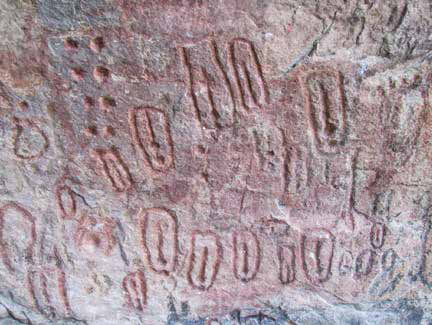 Cupmarks (also called cupules) are a most complicated subject: they are found embedded on walls, ground surfaces, boulders and small rocks. During our research on central Indian rock art, we have noticed many deep and shallow cupmarks. Deep ones exist mostly on the ground surface of painted shelters. It is difficult to understand the real purpose for making them. Still, we have collected some information about their use or meaning.
Nearly every state in India has cupmarks. Their different sizes may be quite varied. Some are associated with painted rock shelters, others with megaliths and some are isolated. In Central India, we have noticed that most cupmarks are associated with rock art sites.
Cupmarks (also called cupules) are a most complicated subject: they are found embedded on walls, ground surfaces, boulders and small rocks. During our research on central Indian rock art, we have noticed many deep and shallow cupmarks. Deep ones exist mostly on the ground surface of painted shelters. It is difficult to understand the real purpose for making them. Still, we have collected some information about their use or meaning.
Nearly every state in India has cupmarks. Their different sizes may be quite varied. Some are associated with painted rock shelters, others with megaliths and some are isolated. In Central India, we have noticed that most cupmarks are associated with rock art sites.
 Cupmarks (also called cupules) are a most complicated subject: they are found embedded on walls, ground surfaces, boulders and small rocks. During our research on central Indian rock art, we have noticed many deep and shallow cupmarks. Deep ones exist mostly on the ground surface of painted shelters. It is difficult to understand the real purpose for making them. Still, we have collected some information about their use or meaning.
Nearly every state in India has cupmarks. Their different sizes may be quite varied. Some are associated with painted rock shelters, others with megaliths and some are isolated. In Central India, we have noticed that most cupmarks are associated with rock art sites.
Cupmarks (also called cupules) are a most complicated subject: they are found embedded on walls, ground surfaces, boulders and small rocks. During our research on central Indian rock art, we have noticed many deep and shallow cupmarks. Deep ones exist mostly on the ground surface of painted shelters. It is difficult to understand the real purpose for making them. Still, we have collected some information about their use or meaning.
Nearly every state in India has cupmarks. Their different sizes may be quite varied. Some are associated with painted rock shelters, others with megaliths and some are isolated. In Central India, we have noticed that most cupmarks are associated with rock art sites.Dogs on a leash in rock art from Saimaluu-Tash in Kyrgyzstan by Luc Hermann
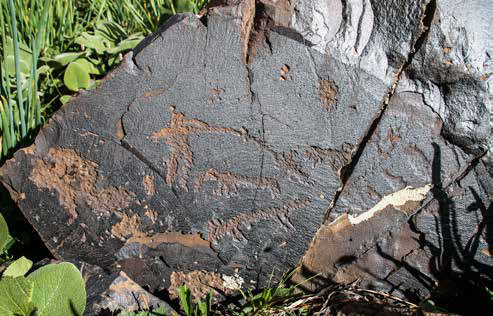 Saimaluu-Tash is located in the center of Kyrgyzstan, circa 40 km south of Kazarman, on the eastern slope of the Fergana range. The main site (called Saimaluu-Tash 1, fig.1) is situated at 3,100m a. s. l. and has been documented in the past 30 years, even if there is no whole publication on it (Martynov et alii 1992; Tashbaeva et alii 2001). A second site (Saimaluu-Tash 2) is located northeast of the main site at an altitude of 3,300m (Fig.2). This site was almost never documented nor published.
In our prospections between 2013 and 2017, 2,320 engraved rocks were documented in Saimaluu-Tash 1 and 1,550 in Saimaluu-Tash 2. The petroglyphs are mainly dated from the Bronze Age, but many are also from the Iron Age and from the Turkic medieval time.
Saimaluu-Tash is located in the center of Kyrgyzstan, circa 40 km south of Kazarman, on the eastern slope of the Fergana range. The main site (called Saimaluu-Tash 1, fig.1) is situated at 3,100m a. s. l. and has been documented in the past 30 years, even if there is no whole publication on it (Martynov et alii 1992; Tashbaeva et alii 2001). A second site (Saimaluu-Tash 2) is located northeast of the main site at an altitude of 3,300m (Fig.2). This site was almost never documented nor published.
In our prospections between 2013 and 2017, 2,320 engraved rocks were documented in Saimaluu-Tash 1 and 1,550 in Saimaluu-Tash 2. The petroglyphs are mainly dated from the Bronze Age, but many are also from the Iron Age and from the Turkic medieval time.
 Saimaluu-Tash is located in the center of Kyrgyzstan, circa 40 km south of Kazarman, on the eastern slope of the Fergana range. The main site (called Saimaluu-Tash 1, fig.1) is situated at 3,100m a. s. l. and has been documented in the past 30 years, even if there is no whole publication on it (Martynov et alii 1992; Tashbaeva et alii 2001). A second site (Saimaluu-Tash 2) is located northeast of the main site at an altitude of 3,300m (Fig.2). This site was almost never documented nor published.
In our prospections between 2013 and 2017, 2,320 engraved rocks were documented in Saimaluu-Tash 1 and 1,550 in Saimaluu-Tash 2. The petroglyphs are mainly dated from the Bronze Age, but many are also from the Iron Age and from the Turkic medieval time.
Saimaluu-Tash is located in the center of Kyrgyzstan, circa 40 km south of Kazarman, on the eastern slope of the Fergana range. The main site (called Saimaluu-Tash 1, fig.1) is situated at 3,100m a. s. l. and has been documented in the past 30 years, even if there is no whole publication on it (Martynov et alii 1992; Tashbaeva et alii 2001). A second site (Saimaluu-Tash 2) is located northeast of the main site at an altitude of 3,300m (Fig.2). This site was almost never documented nor published.
In our prospections between 2013 and 2017, 2,320 engraved rocks were documented in Saimaluu-Tash 1 and 1,550 in Saimaluu-Tash 2. The petroglyphs are mainly dated from the Bronze Age, but many are also from the Iron Age and from the Turkic medieval time.
Find of the (last) decade! The first ships discovered on vertical surfaces on Bornholm by James Dodd & Gerhard Milstreu
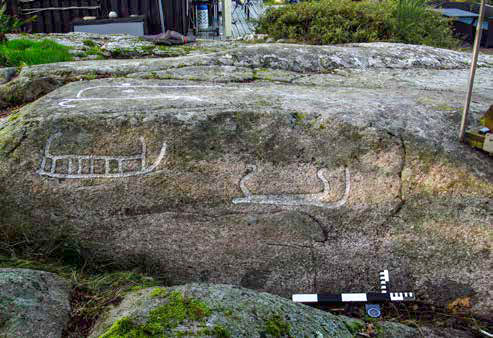 The biggest surprises often come from the most unexpected directions. In this short communication, we present a startling discovery made by the authors during Autumn 2019; the first known instances of figurative rock art carved on vertical surfaces on Bornholm, at Storløkkebakken 7. Here, we present an account of the find history and outline some of the key implications of the findings (more information in Dodd and Milstreu 2020).
In August 2018, whilst documenting rock art panels known in a nearby field, the first named author was invited by the owners onto the grounds of a private property in North Bornholm and encouraged to search for rock art. Almost immediately, one cup-mark was found on the top of an outcrop near the driveway, prompting further furtive efforts on nearby surfaces.
The biggest surprises often come from the most unexpected directions. In this short communication, we present a startling discovery made by the authors during Autumn 2019; the first known instances of figurative rock art carved on vertical surfaces on Bornholm, at Storløkkebakken 7. Here, we present an account of the find history and outline some of the key implications of the findings (more information in Dodd and Milstreu 2020).
In August 2018, whilst documenting rock art panels known in a nearby field, the first named author was invited by the owners onto the grounds of a private property in North Bornholm and encouraged to search for rock art. Almost immediately, one cup-mark was found on the top of an outcrop near the driveway, prompting further furtive efforts on nearby surfaces.
Read the supplementary information: field report, Dodd & Milstreu 2020 here.
 The biggest surprises often come from the most unexpected directions. In this short communication, we present a startling discovery made by the authors during Autumn 2019; the first known instances of figurative rock art carved on vertical surfaces on Bornholm, at Storløkkebakken 7. Here, we present an account of the find history and outline some of the key implications of the findings (more information in Dodd and Milstreu 2020).
In August 2018, whilst documenting rock art panels known in a nearby field, the first named author was invited by the owners onto the grounds of a private property in North Bornholm and encouraged to search for rock art. Almost immediately, one cup-mark was found on the top of an outcrop near the driveway, prompting further furtive efforts on nearby surfaces.
The biggest surprises often come from the most unexpected directions. In this short communication, we present a startling discovery made by the authors during Autumn 2019; the first known instances of figurative rock art carved on vertical surfaces on Bornholm, at Storløkkebakken 7. Here, we present an account of the find history and outline some of the key implications of the findings (more information in Dodd and Milstreu 2020).
In August 2018, whilst documenting rock art panels known in a nearby field, the first named author was invited by the owners onto the grounds of a private property in North Bornholm and encouraged to search for rock art. Almost immediately, one cup-mark was found on the top of an outcrop near the driveway, prompting further furtive efforts on nearby surfaces.
Read the supplementary information: field report, Dodd & Milstreu 2020 here.
Introducing the rock art sites of the Teimareh (Serkoobeh region in Iran) and the feasibility study of organizing these sites in the form of the museum site by Maryam Zanganeh
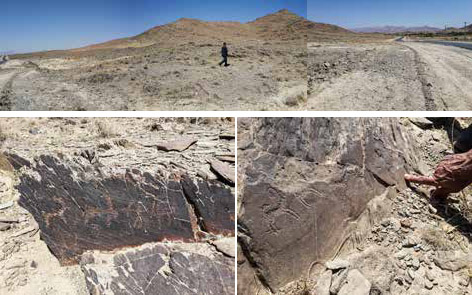 Rock art is one of the oldest works of art and history left by mankind. It is one of the best windows to get to the distant past through which various perspectives of the lives of the people of those ages can be seen. These works are handwritten documents that introduce researchers to translate cultures in different climates and times. One of the important areas of Iranian rock art is located in Markazi province, Khomein and a region called Teimare, which contains vast resources from ancient Iranian rock art.
Rock art in the world is valuable and important from a variety of perspectives and thus extensive efforts are being made to maintain and introduce them nationally and globally.
The main purpose of this study is to present rock art areas and explore the possibility of constructing a museum site in this region. Because if you know the rock art rightly and organize them, while preserving them for the future, you can take a great step in sustainable development and tourism development in the country. The present study was conducted to investigate the rock art of Serkobeh village in Markazi province, Khomein and Teimareh regions to introduce rock art and explore the possibility of constructing a museum site and to organize these sites in the area, in order to preserve and introduce rock art and make it possible to attract tourists.
Rock art is one of the oldest works of art and history left by mankind. It is one of the best windows to get to the distant past through which various perspectives of the lives of the people of those ages can be seen. These works are handwritten documents that introduce researchers to translate cultures in different climates and times. One of the important areas of Iranian rock art is located in Markazi province, Khomein and a region called Teimare, which contains vast resources from ancient Iranian rock art.
Rock art in the world is valuable and important from a variety of perspectives and thus extensive efforts are being made to maintain and introduce them nationally and globally.
The main purpose of this study is to present rock art areas and explore the possibility of constructing a museum site in this region. Because if you know the rock art rightly and organize them, while preserving them for the future, you can take a great step in sustainable development and tourism development in the country. The present study was conducted to investigate the rock art of Serkobeh village in Markazi province, Khomein and Teimareh regions to introduce rock art and explore the possibility of constructing a museum site and to organize these sites in the area, in order to preserve and introduce rock art and make it possible to attract tourists.
 Rock art is one of the oldest works of art and history left by mankind. It is one of the best windows to get to the distant past through which various perspectives of the lives of the people of those ages can be seen. These works are handwritten documents that introduce researchers to translate cultures in different climates and times. One of the important areas of Iranian rock art is located in Markazi province, Khomein and a region called Teimare, which contains vast resources from ancient Iranian rock art.
Rock art in the world is valuable and important from a variety of perspectives and thus extensive efforts are being made to maintain and introduce them nationally and globally.
The main purpose of this study is to present rock art areas and explore the possibility of constructing a museum site in this region. Because if you know the rock art rightly and organize them, while preserving them for the future, you can take a great step in sustainable development and tourism development in the country. The present study was conducted to investigate the rock art of Serkobeh village in Markazi province, Khomein and Teimareh regions to introduce rock art and explore the possibility of constructing a museum site and to organize these sites in the area, in order to preserve and introduce rock art and make it possible to attract tourists.
Rock art is one of the oldest works of art and history left by mankind. It is one of the best windows to get to the distant past through which various perspectives of the lives of the people of those ages can be seen. These works are handwritten documents that introduce researchers to translate cultures in different climates and times. One of the important areas of Iranian rock art is located in Markazi province, Khomein and a region called Teimare, which contains vast resources from ancient Iranian rock art.
Rock art in the world is valuable and important from a variety of perspectives and thus extensive efforts are being made to maintain and introduce them nationally and globally.
The main purpose of this study is to present rock art areas and explore the possibility of constructing a museum site in this region. Because if you know the rock art rightly and organize them, while preserving them for the future, you can take a great step in sustainable development and tourism development in the country. The present study was conducted to investigate the rock art of Serkobeh village in Markazi province, Khomein and Teimareh regions to introduce rock art and explore the possibility of constructing a museum site and to organize these sites in the area, in order to preserve and introduce rock art and make it possible to attract tourists.
Moving ships. A case study from Southwest Norway by Gitte Kjeldsen
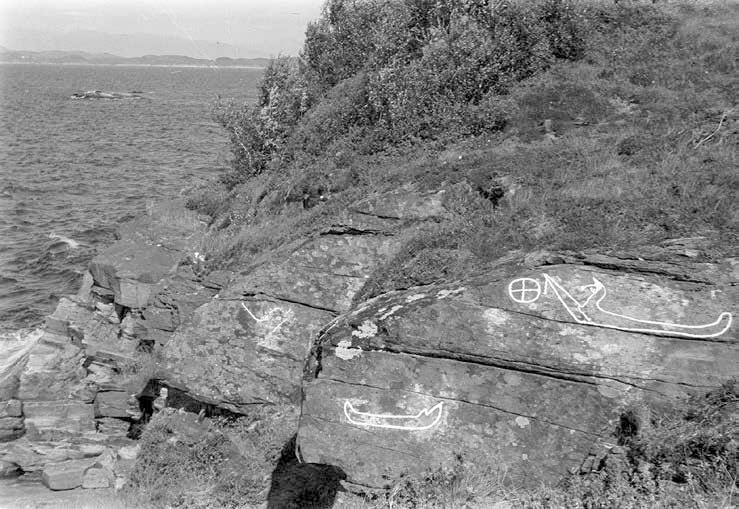 The majority of rock art in SW- Norway is concentrated to the Middle and Northern part on Jæren Stavanger peninsula, as well as the islands and mainland areas in the southern part of Boknafjord. Rock art sites in Rogaland seem to have been selected based on the proximity of water communication points from and around the Boknafjord basin, and further north to Karmsundet and Sunnhordland islands and fjord systems. The rock art is situated in sheltered places like inner skerries close to the shore inlets, bays, natural harbors or headlands (Myhre 2004). Assuming that ships were a part of the everyday life of a coastal Bronze Age population, it is plausible that ships were also part of a beliefs-systems based in a maritime ontology, were ritual actions was part of daily life (Wrigglesworth 2010). Apart from their symbolic and cosmological role, ships have improved human mobility, making it possible to trade over longer distances, increased access to marine based sources of nutrition, facilitated warfare etc., and therefore have agency in forming Bronze Age society. The ship motif comprises approx. 72 % of the rock art in Rogaland, since the initial registration 150 years ago, the number of open rock art locations has increased to 111 sites (Nicolaysen 1867, Høgestøl et al 1999, Høgestøl et al 2018).
The majority of rock art in SW- Norway is concentrated to the Middle and Northern part on Jæren Stavanger peninsula, as well as the islands and mainland areas in the southern part of Boknafjord. Rock art sites in Rogaland seem to have been selected based on the proximity of water communication points from and around the Boknafjord basin, and further north to Karmsundet and Sunnhordland islands and fjord systems. The rock art is situated in sheltered places like inner skerries close to the shore inlets, bays, natural harbors or headlands (Myhre 2004). Assuming that ships were a part of the everyday life of a coastal Bronze Age population, it is plausible that ships were also part of a beliefs-systems based in a maritime ontology, were ritual actions was part of daily life (Wrigglesworth 2010). Apart from their symbolic and cosmological role, ships have improved human mobility, making it possible to trade over longer distances, increased access to marine based sources of nutrition, facilitated warfare etc., and therefore have agency in forming Bronze Age society. The ship motif comprises approx. 72 % of the rock art in Rogaland, since the initial registration 150 years ago, the number of open rock art locations has increased to 111 sites (Nicolaysen 1867, Høgestøl et al 1999, Høgestøl et al 2018).
 The majority of rock art in SW- Norway is concentrated to the Middle and Northern part on Jæren Stavanger peninsula, as well as the islands and mainland areas in the southern part of Boknafjord. Rock art sites in Rogaland seem to have been selected based on the proximity of water communication points from and around the Boknafjord basin, and further north to Karmsundet and Sunnhordland islands and fjord systems. The rock art is situated in sheltered places like inner skerries close to the shore inlets, bays, natural harbors or headlands (Myhre 2004). Assuming that ships were a part of the everyday life of a coastal Bronze Age population, it is plausible that ships were also part of a beliefs-systems based in a maritime ontology, were ritual actions was part of daily life (Wrigglesworth 2010). Apart from their symbolic and cosmological role, ships have improved human mobility, making it possible to trade over longer distances, increased access to marine based sources of nutrition, facilitated warfare etc., and therefore have agency in forming Bronze Age society. The ship motif comprises approx. 72 % of the rock art in Rogaland, since the initial registration 150 years ago, the number of open rock art locations has increased to 111 sites (Nicolaysen 1867, Høgestøl et al 1999, Høgestøl et al 2018).
The majority of rock art in SW- Norway is concentrated to the Middle and Northern part on Jæren Stavanger peninsula, as well as the islands and mainland areas in the southern part of Boknafjord. Rock art sites in Rogaland seem to have been selected based on the proximity of water communication points from and around the Boknafjord basin, and further north to Karmsundet and Sunnhordland islands and fjord systems. The rock art is situated in sheltered places like inner skerries close to the shore inlets, bays, natural harbors or headlands (Myhre 2004). Assuming that ships were a part of the everyday life of a coastal Bronze Age population, it is plausible that ships were also part of a beliefs-systems based in a maritime ontology, were ritual actions was part of daily life (Wrigglesworth 2010). Apart from their symbolic and cosmological role, ships have improved human mobility, making it possible to trade over longer distances, increased access to marine based sources of nutrition, facilitated warfare etc., and therefore have agency in forming Bronze Age society. The ship motif comprises approx. 72 % of the rock art in Rogaland, since the initial registration 150 years ago, the number of open rock art locations has increased to 111 sites (Nicolaysen 1867, Høgestøl et al 1999, Høgestøl et al 2018).
Painted images of Tepsej I rock art site and some questions on their chronology by Irina V. Abolonkova & Alexey K. Solodeynikov
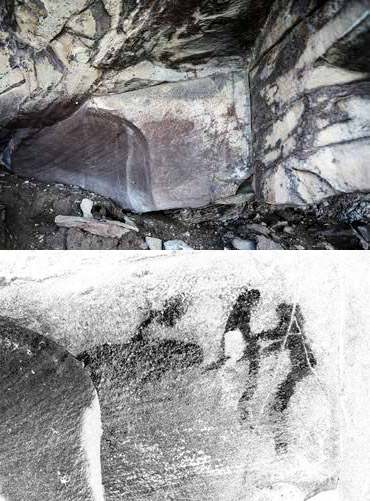 The paper is dedicated to the painted images of Tepsej mountain, which is one of the spacious petroglyphic complexes of Minusinsk basin. Some painted images of very rare type are found on the riverside cliffs at Tepsej I site. The images are hard to see because of their preservation status which is far from being good. Due to the overlapping of the painted images with ancient pecked ones we are able to suggest relative dating of some of the figures. Similar overlapping situations is as unique in the Minusinsk basin, as in South Siberia. Stylistics analysis along with analysis of pigment maps also gives some basis for a relative chronology of the paintings. We consider the findings presented to be an evidence of a wide use of painting techniques in antiquity and to widen the source base of the pre-written history of the South Siberia people.
The paper is dedicated to the painted images of Tepsej mountain, which is one of the spacious petroglyphic complexes of Minusinsk basin. Some painted images of very rare type are found on the riverside cliffs at Tepsej I site. The images are hard to see because of their preservation status which is far from being good. Due to the overlapping of the painted images with ancient pecked ones we are able to suggest relative dating of some of the figures. Similar overlapping situations is as unique in the Minusinsk basin, as in South Siberia. Stylistics analysis along with analysis of pigment maps also gives some basis for a relative chronology of the paintings. We consider the findings presented to be an evidence of a wide use of painting techniques in antiquity and to widen the source base of the pre-written history of the South Siberia people.
 The paper is dedicated to the painted images of Tepsej mountain, which is one of the spacious petroglyphic complexes of Minusinsk basin. Some painted images of very rare type are found on the riverside cliffs at Tepsej I site. The images are hard to see because of their preservation status which is far from being good. Due to the overlapping of the painted images with ancient pecked ones we are able to suggest relative dating of some of the figures. Similar overlapping situations is as unique in the Minusinsk basin, as in South Siberia. Stylistics analysis along with analysis of pigment maps also gives some basis for a relative chronology of the paintings. We consider the findings presented to be an evidence of a wide use of painting techniques in antiquity and to widen the source base of the pre-written history of the South Siberia people.
The paper is dedicated to the painted images of Tepsej mountain, which is one of the spacious petroglyphic complexes of Minusinsk basin. Some painted images of very rare type are found on the riverside cliffs at Tepsej I site. The images are hard to see because of their preservation status which is far from being good. Due to the overlapping of the painted images with ancient pecked ones we are able to suggest relative dating of some of the figures. Similar overlapping situations is as unique in the Minusinsk basin, as in South Siberia. Stylistics analysis along with analysis of pigment maps also gives some basis for a relative chronology of the paintings. We consider the findings presented to be an evidence of a wide use of painting techniques in antiquity and to widen the source base of the pre-written history of the South Siberia people.
Rock art and Celto-Germanic vocabulary. Shared iconography and words as reflections of Bronze Age contact by John T. Koch
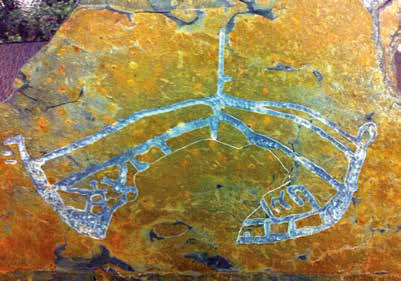 Recent discoveries in the chemical and isotopic sourcing of metals and ancient DNA have transformed our understanding of the Nordic Bronze Age in two key ways. First, we find that Scandinavia and the Iberian Peninsula were in contact within a system of longdistance exchange of Baltic amber and Iberian copper. Second, by the Early Bronze Age, mass migrations emanating from the Pontic-Caspian steppe had reached both regions, probably bringing Indo-European languages with them. In the light of these discoveries, we launched a research project in 2019 — ‘Rock art, Atlantic Europe, Words & Warriors (RAW)’ — based at the University of Gothenburg and funded by the Swedish Research Council (Vetenskapsrådet). The RAW project undertakes an extensive programme of scanning and documentation to enable detailed comparison of the strikingly similar iconography of Scandinavian rock art and Iberian ‘warrior’ stelae. A linguistic aspect of this cross-disciplinary project is to re-examine the inherited word stock shared by Celtic and Germanic, but absent from the other Indo-European languages, exploring how these words might throw light onto the world of meaning of Bronze rock art and the people who made it. This paper presents this linguistic aspect of the RAW project and some preliminary findings.
Recent discoveries in the chemical and isotopic sourcing of metals and ancient DNA have transformed our understanding of the Nordic Bronze Age in two key ways. First, we find that Scandinavia and the Iberian Peninsula were in contact within a system of longdistance exchange of Baltic amber and Iberian copper. Second, by the Early Bronze Age, mass migrations emanating from the Pontic-Caspian steppe had reached both regions, probably bringing Indo-European languages with them. In the light of these discoveries, we launched a research project in 2019 — ‘Rock art, Atlantic Europe, Words & Warriors (RAW)’ — based at the University of Gothenburg and funded by the Swedish Research Council (Vetenskapsrådet). The RAW project undertakes an extensive programme of scanning and documentation to enable detailed comparison of the strikingly similar iconography of Scandinavian rock art and Iberian ‘warrior’ stelae. A linguistic aspect of this cross-disciplinary project is to re-examine the inherited word stock shared by Celtic and Germanic, but absent from the other Indo-European languages, exploring how these words might throw light onto the world of meaning of Bronze rock art and the people who made it. This paper presents this linguistic aspect of the RAW project and some preliminary findings.
 Recent discoveries in the chemical and isotopic sourcing of metals and ancient DNA have transformed our understanding of the Nordic Bronze Age in two key ways. First, we find that Scandinavia and the Iberian Peninsula were in contact within a system of longdistance exchange of Baltic amber and Iberian copper. Second, by the Early Bronze Age, mass migrations emanating from the Pontic-Caspian steppe had reached both regions, probably bringing Indo-European languages with them. In the light of these discoveries, we launched a research project in 2019 — ‘Rock art, Atlantic Europe, Words & Warriors (RAW)’ — based at the University of Gothenburg and funded by the Swedish Research Council (Vetenskapsrådet). The RAW project undertakes an extensive programme of scanning and documentation to enable detailed comparison of the strikingly similar iconography of Scandinavian rock art and Iberian ‘warrior’ stelae. A linguistic aspect of this cross-disciplinary project is to re-examine the inherited word stock shared by Celtic and Germanic, but absent from the other Indo-European languages, exploring how these words might throw light onto the world of meaning of Bronze rock art and the people who made it. This paper presents this linguistic aspect of the RAW project and some preliminary findings.
Recent discoveries in the chemical and isotopic sourcing of metals and ancient DNA have transformed our understanding of the Nordic Bronze Age in two key ways. First, we find that Scandinavia and the Iberian Peninsula were in contact within a system of longdistance exchange of Baltic amber and Iberian copper. Second, by the Early Bronze Age, mass migrations emanating from the Pontic-Caspian steppe had reached both regions, probably bringing Indo-European languages with them. In the light of these discoveries, we launched a research project in 2019 — ‘Rock art, Atlantic Europe, Words & Warriors (RAW)’ — based at the University of Gothenburg and funded by the Swedish Research Council (Vetenskapsrådet). The RAW project undertakes an extensive programme of scanning and documentation to enable detailed comparison of the strikingly similar iconography of Scandinavian rock art and Iberian ‘warrior’ stelae. A linguistic aspect of this cross-disciplinary project is to re-examine the inherited word stock shared by Celtic and Germanic, but absent from the other Indo-European languages, exploring how these words might throw light onto the world of meaning of Bronze rock art and the people who made it. This paper presents this linguistic aspect of the RAW project and some preliminary findings.
The cupmark conundrum: A Welsh Neolithic perspective by George Nash
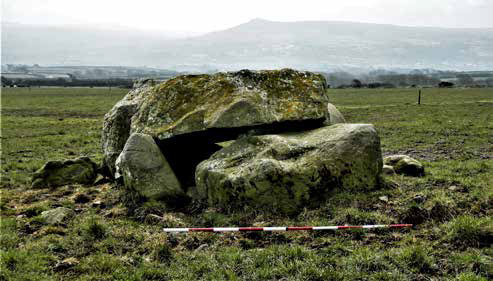 One of the most enigmatic symbols of the later prehistoric world is the humble cupmark (or cupule). Arguably simple to construct, cupmarks are the most common engraved motifs found in Neolithic and Bronze Age Europe. Within the western British Isles, they usually occur on rock outcropping or on top of the capstones of burial-ritual monuments. Occasionally, they are also found on upright stones that form the inner architecture of monuments. However, cupmarks are only found on or near a relatively small number of burial-ritual monuments suggesting several possible scenarios. In this paper I will describe and discuss the evidence that surrounds these simple motifs and suggest reasons why prehistoric communities in this part of western Britain and along the Atlantic Seaboard of Europe found them to be such a potent symbol.
Rock art research in Wales is a relatively new branch of prehistoric research with only several books and a handful of academic papers being published. Much of the most recent research has been produced by the Welsh Rock Art Organisation (WRAO) and the late John Sharkey. Since an inaugural meeting in Bangor, North Wales in 2004, when the Welsh Rock art Organisation was initially conceived, one of the aims was to data-gather information of known rock art sites in Wales and the Borderlands.
One of the most enigmatic symbols of the later prehistoric world is the humble cupmark (or cupule). Arguably simple to construct, cupmarks are the most common engraved motifs found in Neolithic and Bronze Age Europe. Within the western British Isles, they usually occur on rock outcropping or on top of the capstones of burial-ritual monuments. Occasionally, they are also found on upright stones that form the inner architecture of monuments. However, cupmarks are only found on or near a relatively small number of burial-ritual monuments suggesting several possible scenarios. In this paper I will describe and discuss the evidence that surrounds these simple motifs and suggest reasons why prehistoric communities in this part of western Britain and along the Atlantic Seaboard of Europe found them to be such a potent symbol.
Rock art research in Wales is a relatively new branch of prehistoric research with only several books and a handful of academic papers being published. Much of the most recent research has been produced by the Welsh Rock Art Organisation (WRAO) and the late John Sharkey. Since an inaugural meeting in Bangor, North Wales in 2004, when the Welsh Rock art Organisation was initially conceived, one of the aims was to data-gather information of known rock art sites in Wales and the Borderlands.
 One of the most enigmatic symbols of the later prehistoric world is the humble cupmark (or cupule). Arguably simple to construct, cupmarks are the most common engraved motifs found in Neolithic and Bronze Age Europe. Within the western British Isles, they usually occur on rock outcropping or on top of the capstones of burial-ritual monuments. Occasionally, they are also found on upright stones that form the inner architecture of monuments. However, cupmarks are only found on or near a relatively small number of burial-ritual monuments suggesting several possible scenarios. In this paper I will describe and discuss the evidence that surrounds these simple motifs and suggest reasons why prehistoric communities in this part of western Britain and along the Atlantic Seaboard of Europe found them to be such a potent symbol.
Rock art research in Wales is a relatively new branch of prehistoric research with only several books and a handful of academic papers being published. Much of the most recent research has been produced by the Welsh Rock Art Organisation (WRAO) and the late John Sharkey. Since an inaugural meeting in Bangor, North Wales in 2004, when the Welsh Rock art Organisation was initially conceived, one of the aims was to data-gather information of known rock art sites in Wales and the Borderlands.
One of the most enigmatic symbols of the later prehistoric world is the humble cupmark (or cupule). Arguably simple to construct, cupmarks are the most common engraved motifs found in Neolithic and Bronze Age Europe. Within the western British Isles, they usually occur on rock outcropping or on top of the capstones of burial-ritual monuments. Occasionally, they are also found on upright stones that form the inner architecture of monuments. However, cupmarks are only found on or near a relatively small number of burial-ritual monuments suggesting several possible scenarios. In this paper I will describe and discuss the evidence that surrounds these simple motifs and suggest reasons why prehistoric communities in this part of western Britain and along the Atlantic Seaboard of Europe found them to be such a potent symbol.
Rock art research in Wales is a relatively new branch of prehistoric research with only several books and a handful of academic papers being published. Much of the most recent research has been produced by the Welsh Rock Art Organisation (WRAO) and the late John Sharkey. Since an inaugural meeting in Bangor, North Wales in 2004, when the Welsh Rock art Organisation was initially conceived, one of the aims was to data-gather information of known rock art sites in Wales and the Borderlands.

|

